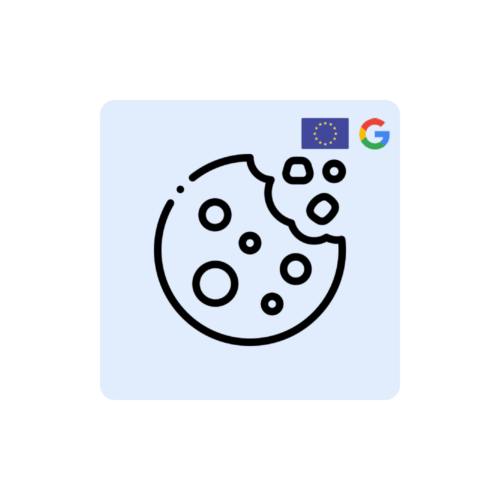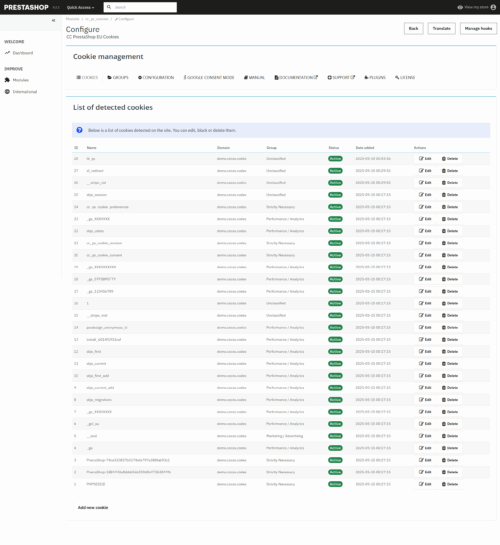CC PrestaShop EU Cookies Documentation
Comprehensive documentation for the cookie consent management module for PrestaShop compliant with RODO, ePrivacy and Google Consent Mode 2.0 (cc_ps_cookies).Table of contents
- Introduction
- Installation
- License activation
- Management panel
- Cookie management
- Managing groups of cookies
- Appearance configuration
- Integration with Google Consent Mode
- Using the module in templates
- Troubleshooting
- FAQ
1. introduction
CC PrestaShop EU Cookies is an advanced cookie consent management module compliant with RODO, ePrivacy and Google Consent Mode 2.0. The module provides full control over the cookies used in the store, allowing you to group, block and present them to users in an aesthetically pleasing way.The module offers:
- Automatic detection of cookies used in the store
- Grouping cookies by category
- Blocking cookies that you have not consented to
- Customizable consent banner with different styles
- Full integration with Google Consent Mode 2.0
- Compliance with RODO and ePrivacy requirements
- Multilingualism support
- Advanced API for use in templates
2 Installation
System requirements- PrestaShop 1.7 or later
- PHP 7.0 or later
- Permission to install modules
- Download the ZIP file of the module from the official store cocos.codes
- Log in to your PrestaShop admin panel
- Go to: Modules > Module Manager > Add New Module
- Click "Add Module" and select the downloaded ZIP file
- When the installation is complete, click "Configure"
Info
After installation, the module will automatically create default cookie groups and create the necessary database tables. It will be necessary to configure the module and activate the license before full use of all features.
3. license activation
It is necessary to activate the license before using the full functionality of the module:- After installation, go to configure the module
- Select the "License" tab
- Enter the license key you received after purchase
- Click "Activate License"
- After successful activation, you will see a confirmation message and all functions of the module will be unlocked
Warning
Without an active license, the module will operate in limited mode, without all advanced features. A message about the inactive license will be displayed at the top of the administration panel.
4. management panel
The module's management panel consists of several tabs that allow full configuration:Main tabs:
- Cookies - managing detected cookies
- Groups - managing groups of cookies
- Configuration - general settings of the module and banner appearance
- Google Consent Mode - Google Consent Mode 2.0 integration configuration
- Handbook - instructions and examples of use
- Plugins - additional extensions for the module
- License - module license management
General functionalities:
- Turning the module on/off
- Automatic cookie detection
- Set the default group for newly detected cookies
- Hiding the banner from robots (bots)
- Refresh page after changing cookie preferences
- Managing consent revisions (forcing the banner to be shown again)
Tip
To force the re-display of the consent banner for all users, increase the revision number in the general settings of the module. This is useful, for example, after introducing new cookie categories or changing the privacy policy.
5. cookie management
The "Cookies" tab allows you to manage all detected cookies in the store:List of cookies
- Cookie name
- Domain
- Assigned group
- Status (active/blocked)
- Date added
- Available actions
- Click the "Add New Cookie" or "Edit" button next to an existing one
- Fill out the cookie data form:
- Name of cookie - unique cookie name
- Domain - the domain for which the cookie is stored
- Track - cookie path (default "/")
- Group - Assignment to a group of cookies (e.g., essential, analytical, marketing)
- Description - description of the function of the cookie visible to users
- Status - active or blocked
- Click "Save" to save the changes
The module offers the ability to automatically detect cookies used in the store. This function:
- Detects new cookies while browsing the site
- Automatically assigns them to the appropriate groups based on a built-in database of cookie names
- Adds default description for recognized cookies
- Assigns unrecognized cookies to the "Uncategorized" group.
Note
Automatic detection works when users browse the site. To detect all cookies in use, we recommend reviewing the various sections of the store after enabling this feature. Note that some cookies may only be loaded under certain conditions, such as when adding a product to the shopping cart.
6. cookie group management
The "Groups" tab allows you to manage categories of cookies:Default groups
- Necessary (strictly_necessary) - cookies necessary for the operation of the site
- Functional - cookies that allow personalization of functions
- Statistical/Analytical (performance) - cookies that collect traffic information
- Marketing (marketing) - cookies used for advertising and profiling
- Unclassified - cookies not yet assigned to a category
- Add, edit and delete groups (except default ones)
- Set group mandatory (groups marked as required cannot be rejected by the user)
- Set group activity status
- Changing the display order of groups in the banner
- Managing translations of group names and descriptions
Info
By default, only the "Strictly_necessary" group is marked as required. This property cannot be changed for the default group of essential cookies. This group will always be active, regardless of user preferences.
7. appearance configuration
The "Configuration" tab allows you to customize the appearance of the cookie consent banner:Message settings
- Message title (with multilingual support)
- Message content (with support for multilingualism)
- Banner style (bar, window, cloud)
- Horizontal position (left, center, right)
- Vertical position (top, middle, bottom)
- Maximum width
- Rounding the corners
- Shadow
- Background color
- Text color
- Button colors (background and text) for "Accept all", "Accept selected" and "Reject all"
- Custom CSS
A mini-banner is a small button displayed after closing the main banner, which allows the user to reopen the cookie settings.
- Mini-banner position (left/right side)
- Distance from bottom of page
- Mini-banner size
- Shape (round, rounded, square)
- Background color
- Icon type (Material Icon, predefined images, custom URL)
- Icon color
- Hover effect (zoom, rotate, none)
Tip
The "Show banner preview" button allows you to preview the appearance of the banner with the current settings before saving the changes. You can experiment with different styles to choose the optimal look to match your store's layout.
8 Integration with Google Consent Mode
The "Google Consent Mode" tab allows you to configure Google Consent Mode 2.0 integration:General settings
- Enabling/disabling Google Consent Mode
- Setting whether the Google Tag code is already installed in the store
- Google Tag ID entry (for Google Analytics 4 or Google Tag Manager).
- URL Passthrough - passing campaign parameters via URL.
- Ads data editing - removing conversion information in the absence of consent
- Waiting time (ms) - the delay before Google Tags is launched
- Assign Google consent types to each group of cookies
- Available consent types:
- Ad storage (ad_storage)
- Ads user data (ad_user_data)
- Ad personalization (ad_personalization)
- Analytics storage (analytics_storage)
- Functionality storage (functionality_storage)
- Personalization storage (personalization_storage)
- Security storage (security_storage)
Warning
In order for Google Consent Mode to work properly, it is necessary to provide a valid Google Tag ID (G-XXXXXXXXXX) or check the option that the Google Tag/GTM code is already installed in the store. Without this, the function will not work properly.
9. use of module in templates
The module offers API functions that can be used in store templates:Checking user consent
In Smarty templates, you can check whether the user has agreed to a certain group of cookies using the function cc_ps_cookies_has_consent:
{if {cc_ps_cookies_has_consent group='functional'}}
<div class="alert alert-success">Your consent for functional cookies has been given!</div>
{else}
<div class="alert alert-warning">No consent for functional cookies.</div>
{/if}To place a button anywhere in the template to open the cookie management window, you can use the hookup displayCcPsCookiesButton:
{hook h='displayCcPsCookiesButton'}.{hook h='displayCcPsCookiesButton' class="btn btn-primary btn-sm" text="Privacy settings" icon="lock"}The module also provides a JavaScript API for checking the status of consents and listening for changes to them:
// Sprawdzanie zgody na grupę cookies
if (window.ccPsCoookieConsent && typeof window.ccPsCoookieConsent.hasConsent === 'function') {
if (window.ccPsCoookieConsent.hasConsent('performance')) {
console.log('Zgoda na analityczne pliki cookie została wyrażona!');
// Tutaj możesz inicjalizować np. Google Analytics
}
}
// Nasłuchiwanie na zdarzenie zmiany preferencji cookies
document.addEventListener('cc_ps_cookies_preferences_changed', function(event) {
if (event?.detail?.preferences) {
console.log('Preferencje cookie zostały zmienione:', event.detail.preferences);
}
});Tip
Additional examples of API usage and detailed documentation are available in the "Manual" tab of the module's administration panel.
10. troubleshooting
Cookie banner does not display- Check if the module is enabled in the "Configuration" tab.
- Make sure the license is active
- Make sure the displayFooter hook is registered and working properly
- Check that you do not have "Hide from bots" enabled and that your browser is not identified as a bot
- Check if the user has not already saved cookie preferences - increase the revision number to force a redisplay
- Make sure automatic cookie detection is enabled
- Check that cookies are assigned to the right groups
- Make sure the cookie-blocker.js script is loaded correctly
- Check whether the site uses a custom cookie setting mechanism that bypasses the standard document.cookie function
- Make sure Google Consent Mode is enabled
- Check if the Google Tag ID is correct (for G-XXXXXXXXXX) or if the Google Tag code is already installed
- Make sure the mapping of cookie groups to Google categories is properly configured
- Check if the google-consent-mode.js script is loaded correctly
Error
If you encounter unsolvable problems with the module, please make sure you are using the latest version and that your PrestaShop store is up to date. In case of difficulties, contact COCOS support via the following page. cocos.codes/support.
11 FAQS.
Does the module automatically block cookies that the user has not consented to?Yes, the module automatically blocks cookies that have been marked as blocked and do not belong to the group that the user has agreed to.
Is the module compliant with RODO and ePrivacy?
Yes, the module is designed in accordance with the requirements of RODO and the ePrivacy Directive, allowing users to give informed consent to the cookies used in the store.
Does the module support multiple languages?
Yes, the module fully supports multilingualism. The title, the message and the descriptions of groups and cookies can be translated into all languages of the store.
Can I use the module without Google Consent Mode?
Yes, integration with Google Consent Mode is optional. You can only use the module to manage cookie consents without Google integration.
Does the module work with analytics tools other than Google Analytics?
Yes, the module can be used with any analytical tools through API functions for checking user consents. See the "Manual" tab for integration examples.
How often is the module updated?
The module is regularly updated to ensure compliance with the latest regulations and technical requirements. Holders of a valid license have access to all updates.
Can I transfer the license to another store?
The license is assigned to one domain. If you change your store's domain, please contact COCOS support to transfer the license.
Does the module affect the performance of the store?
The module has been optimized for performance and should not significantly affect the page loading time. You can disable automatic cookie detection if you notice any slowdown.









